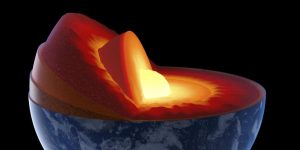
It is widely accepted that the Earth’s inner core formed about a billion years ago when a solid, super-hot iron nugget spontaneously began to crystallize inside a 4,200-mile-wide ball of liquid metal at the planet’s center.
One problem: That’s not possible-or, at least, has never been easily explained-according to a new paper published in Earth and Planetary Science Letters from a team of scientists at Case Western Reserve University.
The research team-comprised of post-doctoral student Ludovic Huguet; Earth, Environmental, and Planetary Sciences professors James Van Orman and Steven Hauck II; and Materials Science and Engineering Professor Matthew Willard-refer to this enigma as the “inner-core nucleation paradox.”
That paradox goes like this: Scientists have known for more than 80 years that a crystallized inner core exists. But the Case Western Reserve team asserts that this widely accepted idea neglects one critical point-one that, once added, would suggest the inner core shouldn’t exist.
The inner core contradiction
Here’s why: While it is well known that a material must be at or below its freezing temperature to be solid, it turns out that making the first crystal from a liquid takes extra energy. That extra energy-the nucleation barrier-is the ingredient that models of Earth’s deepest interior have not included until now.
To overcome the nucleation barrier and start to solidify, however, the liquid has to be cooled well below its freezing point-what scientists call “supercooling.”
Alternatively, something different has to be added to the liquid metal of the core-at the center of the planet-that substantially reduces the amount of required supercooling.
But the nucleation barrier for metal-at the extraordinary pressures at the center of the Earth-is enormous.
“Everyone, ourselves included, seemed to be missing this big problem-that metals don’t start crystallizing instantly unless something is there that lowers the energy barrier a lot,” Hauck said.
The Case Western Reserve team contends the most obvious solutions are suspect:
” That the inner core was somehow subjected to a massive supercooling of about 1,800 degrees Fahrenheit (1,000 Kelvin)-well beyond the amount of cooling scientists have concluded. If the Earth’s center had reached this temperature, nearly the entire core should be crystallizing rapidly, but the evidence indicates that it is not.
“That something happened to lower the nucleation barrier, allowing crystallization to occur at a higher temperature. Scientists do this in the lab by adding a piece of solid metal to a slightly supercooled liquid metal, causing the now-heterogeneous material to quickly solidify. But it’s difficult to figure on an earth-sized scale how this could have happened, how a nucleation enhancing solid could have found its way to the center of the planet to allow for the hardening (and expansion) of the inner core, Huguet said.
“So, if the core is a pure (homogenous) liquid, the inner core shouldn’t exist at all because it could not have been supercooled to that extent,” Van Orman said. “And if it’s not homogeneous, how did it become so?
“That’s the inner-core nucleation paradox.”
Possible answers
Then how did the solid inner core form?
At the moment, the team’s favored idea is akin to the second solution above: that large bodies of solid metal slowly dropped from the rocky mantle and into the core to lower the nucleation barrier.
But that would require a massive nugget-maybe the size of a large city-to be heavy enough to drop through the mantle and then large enough to make it the core without entirely dissolving.
If that’s the case, “we need to figure out how that could actually happen,” Van Orman said.
“On the other hand,” he said, “is there some ordinary feature of planetary cores that we have not thought of before-something that allows them to overcome that nucleation barrier?
“It’s time for the whole community to think about this problem and how to test it. The inner core exists, and now we have to figure out how it got there.”
Note: The above post is reprinted from materials provided by Case Western Reserve University.










